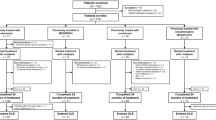Summary
Four patients with sporadic olivopontocerebellar atrophy (OPCA) and severe signs of Parkinsonism received continuous subcutaneous lisuride infusion via a small external pump. All 4 patients benefitted from this treatment: 3 showed an overall improvement in motor performance, in 1 patient mainly dysphagia and dysarthria improved. Therapeutic benefit lasted for at least 6 months of follow up. With a daily dose of 1.0 mg of subcutaneous lisuride, treatment limitations were reached in the form of dysphagia, probably due to oropharyngeal dystonia. Subcutaneous lisuride infusion should be taken into consideration in OPCA patients with signs of Parkinsonism if oral dopaminergic treatment has failed earlier on.
Similar content being viewed by others
References
Ahlenius S, Larsson K (1985) Antagonism by lisuride and 8-OH-DPAT of 5-HPT-induced prolongation of the performance of male rat sexual behavior. Eur J Pharmacol 110: 379–381
Berciano J (1982) Olivopontocerebellar atrophy. J Neurol Sci 53: 252–272
Bittkau S, Przuntek H (1986) Lisuride infusion pump for Parkinson's disease. Lancet ii: 349
Critchley PHS, Grandas Perez F, Quinn NP, Parkes JD, Marsden CD (1988) Continuous subcutaneous lisuride infusions in Parkinson's disease. J Neural Transm [Suppl] 27: 55–60
Currier AC (1984) A classification for ataxia. In: Duvoisin RC, Plaitakis A (eds) The Olivopontocerebellar atrophies. Raven Press, New York, pp 1–4
Deutch A, Rosin DC, Goldstein M, Roth RH (1989) 3-Acetylpyridine-induced degeneration of the nigrostriatal dopamine system: an animal model of Olivopontocerebellar atrophy-associated parkinsonism. Exp Neurol 105: 1–9
Fearnley JM, Lees AJ (1990) Striatonigral degeneration. Brain 113: 1823–1842
Goetz CG, Tanner CM, Klawans HL (1984) The pharmacology of OPCA. In: Duvoisin RC, Plaitakis A (eds) The Olivopontocerebellar atrophies. Raven Press, New York, pp 1–4
Horowski R, Obeso JA (1990) Lisuride: a direct dopamine agonist in the treatment of Parkinson's disease. In: Koller WC, Paulson G (eds) Therapy in Parkinson's disease. Marcel Dekker, New York, pp 269–309
Jellinger K, Tarnowska-Dziduszko E (1971) Die ZNS-VerÄnderungen bei den olivo-pontocerebellÄren Atrophien. Z Neurol 199: 192–214
Klawans HL, Zeitlin E (1971) Levodopa in Parkinsonism associated with cerebellar dysfunction (probably Olivopontocerebellar degeneration). J Neurol Neurosurg Psychiatry 34: 14–19
Lammare Y, de Montigny C, Dumont M, Weiss M (1971) Harmaline-induced rhythmic activity of cerebellar and lower brain stem neurons. Brain Res 32: 246–250
Lees AJ, Bannister R (1981) The use of lisuride in the treatment of multiple system atrophy with autonomic failure (Shy-Drager syndrome). J Neurol Neurosurg Psychiatry 44: 347–351
Obeso JA, Luquin MR, Martinez-Lage JM (1986) Lisuride ifusion pump: a device for the treatment of motor fluctuations in Parkinson's disease. Lancet i: 467–470
Parkes JD, Schachter M, Marsden CD, Smith B, Wilson A (1981) Lisuride in parkinsonism. Ann Neurol 9: 48–52
Plaitakis A, Nicklas WJ, Berl S (1978) Thiamine deficiency: selective impairment of the cerebellar serotonergic system. Neurology 28: 691–698
Polinsky RJ (1984) Multiple system atrophy: clinical aspects, pathophysiology and treatment. Neurol Clin 2: 487–498
Trouillas P (1988) Improvement of cerebellar ataxia with levorotatory form of 5-hydroxy-tryptophan. Arch Neurol 45: 1217–1222
Author information
Authors and Affiliations
Rights and permissions
About this article
Cite this article
Heinz, A., Wöhrle, J., Schöls, L. et al. Continuous subcutaneous lisuride infusion in OPCA. J. Neural Transmission 90, 145–150 (1992). https://doi.org/10.1007/BF01250796
Received:
Accepted:
Issue Date:
DOI: https://doi.org/10.1007/BF01250796




